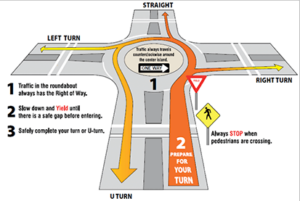We in Collier county are starting to see more and more roundabouts. Do you know how to navigate these roundabouts? Read below the official Florida FAQ from the FDOT. Drive safe!
Below you will find a listing of frequently asked questions related to Florida’s Roundabouts.
What is the difference between a roundabout and a traffic circle?
Traffic circles are much larger than a roundabout and often have stop signs or signals within the circular intersection. Roundabouts are smaller and vehicles have to yield before entering. A good example of a traffic circle is the intersection of US1 and Hollywood Blvd in Broward County (Click here for a Google Maps link). >Roundabouts typically operate at relatively low speeds (25 MPH) while traffic circles allow higher speeds (> 25 MPH). >Roundabouts restrict pedestrians from entering the central island while some traffic circles allow pedestrians to cross to and from the central island.
How do I drive in a single-lane roundabout?
Reduce your speed to 10-15 mph as you approach the roundabout; be aware of bicyclists and pedestrians; look left for oncoming traffic (traffic moves counter-clockwise); yield to vehicles already in the roundabout, wait for a gap and enter; do not stop in the roundabout; do not pass other vehicles; use turn signal to exit the roundabout to the right; yield to pedestrians crossing the exit lane; allow emergency vehicles to pass.
How do I drive in a multi-lane roundabout?
Follow signs and pavement markings to determine the lane(s) that will serve your destination; follow all tips listed for the single-lane roundabout.
How should drivers yield to emergency vehicles?
If you have not entered the roundabout, pull over to the right and allow the emergency vehicle to pass. If you have already entered the roundabout, continue to the closest exit and pull over once you are beyond the splitter island to allow the emergency vehicle to pass. Never stop in a roundabout.
Should I stop inside the roundabout to let someone in?
No. You may slow down so the safe gap becomes more obvious to the driver wanting to enter the roundabout; however, you should not stop after crossing the yield line and are actually in the roundabout circle.
How are pedestrians accommodated?
Pedestrians use marked crosswalks. All roundabouts have splitter islands that separate the approach and exit lanes. This splitter island is used as a pedestrian refuge for crosswalks requiring pedestrians to only cross a single direction of traffic at a time.
What about visually impaired pedestrians?
Roundabouts may have an advantage to the visually impaired because they only have to address a single direction at one time and they can more easily distinguish between the vehicle noises. Also, slower vehicle speeds are generally safer for pedestrians.
How are bicyclists accommodated?
Bicyclists should be encouraged to both share the travel way with vehicles in a roundabout, or dismount and use the sidewalk and crosswalk system to navigate through the roundabout.
How will large trucks be accommodated?
Roundabouts are designed to accommodate all the turning movements of a tractor trailer rig. To accommodate the sweep of the trailer wheels as it makes its way through the roundabout, a truck apron is constructed around the inside of the circulating roadway. The apron is constructed of a different material or colored differently than the circulating roadway, to distinguish it and to make it clear that the truck apron is not something to be driven over by smaller vehicles.
#GKHomeWatch
#Roundabouts
#SafeDriving

Recent Comments